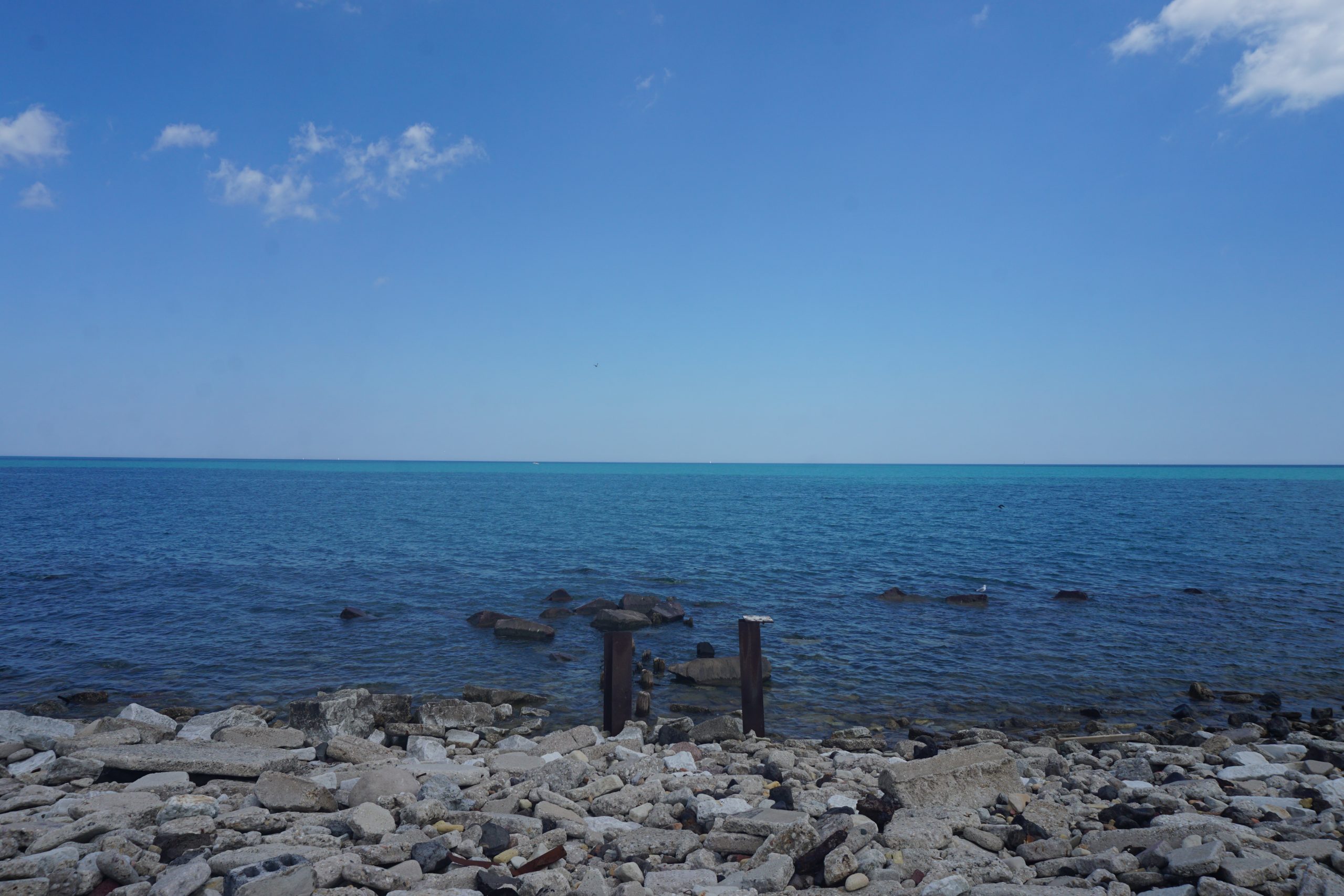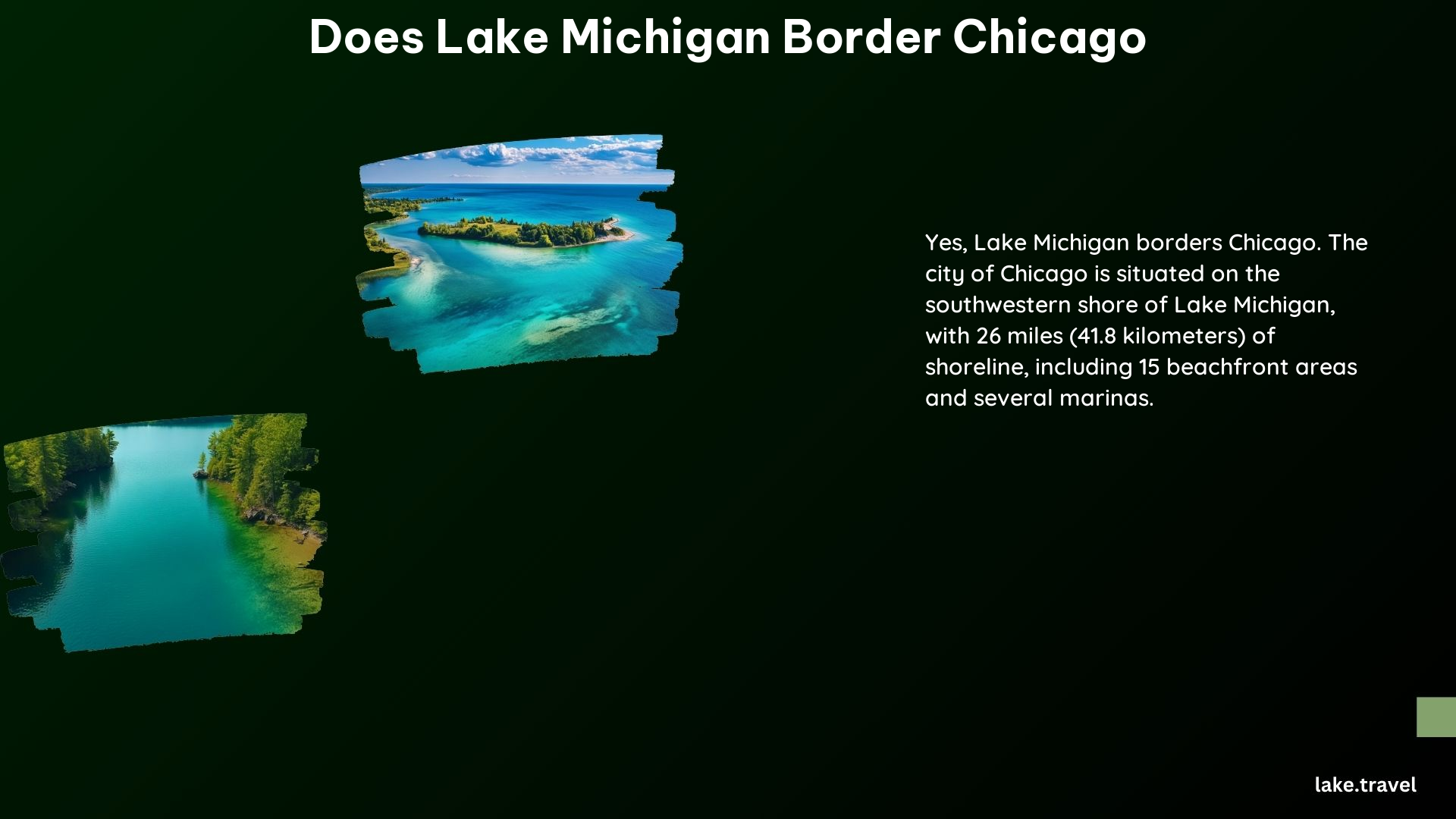Yes, Lake Michigan borders the city of Chicago. Chicago is located on the southwestern shore of Lake Michigan, and the lake forms a significant part of the city’s waterfront. The city has 26 miles (41.8 kilometers) of Lake Michigan shoreline, featuring 15 beachfront areas and several marinas housing thousands of boats.
The Significance of Lake Michigan to Chicago

Lake Michigan is an integral part of Chicago’s identity and history. The lake has played a crucial role in the city’s development, serving as a hub for transportation, commerce, and recreation. Here are some key points about the significance of Lake Michigan to Chicago:
-
Transportation Hub: Chicago’s location on the shores of Lake Michigan has made it a major transportation hub. The city’s ports and harbors have facilitated the movement of goods and people across the Great Lakes region and beyond.
-
Economic Powerhouse: The lake has been a vital resource for Chicago’s economy, providing access to water-based transportation, fishing, and other industries. The city’s proximity to the lake has also attracted businesses and industries that rely on the lake’s resources.
-
Recreational Destination: Lake Michigan offers a wide range of recreational activities for Chicagoans and visitors alike. The city’s beaches, marinas, and parks along the lakefront are popular destinations for swimming, boating, fishing, and other outdoor activities.
-
Environmental Importance: Lake Michigan is a crucial natural resource, providing drinking water for millions of people in the region. The lake’s ecosystem also supports a diverse array of wildlife, including migratory birds and various fish species.
Chicago’s Lakefront and Beaches

Chicago’s lakefront is a defining feature of the city, stretching for 26 miles along the southwestern shore of Lake Michigan. The lakefront is home to numerous parks, beaches, and recreational facilities, making it a popular destination for both residents and tourists.
Beaches
Chicago’s lakefront features 15 public beaches, each with its own unique character and amenities. Some of the most popular beaches include:
-
North Avenue Beach: This iconic beach is known for its lively atmosphere, with beachgoers enjoying volleyball, sunbathing, and other activities.
-
Oak Street Beach: Situated in the heart of the city, Oak Street Beach offers stunning views of the Chicago skyline and is a popular spot for sunbathing and swimming.
-
Montrose Beach: Montrose Beach is the largest beach in Chicago, offering ample space for beachgoers to enjoy the lake and its surroundings.
-
Calumet Beach: Located in the southern part of the city, Calumet Beach is a quieter and more secluded option, offering a more peaceful lakefront experience.
Lakefront Parks
In addition to the beaches, Chicago’s lakefront is home to numerous parks and green spaces, including:
-
Grant Park: Also known as the “Front Yard of Chicago,” Grant Park is a sprawling urban park that features the iconic Buckingham Fountain and hosts various events and festivals throughout the year.
-
Millennium Park: This world-renowned park is home to the famous Cloud Gate sculpture, also known as “The Bean,” and offers stunning views of the Chicago skyline.
-
Lincoln Park: Stretching along the lakefront for several miles, Lincoln Park is the largest park in Chicago and offers a wide range of recreational activities, including a zoo, conservatory, and nature trails.
-
Northerly Island: Formerly the site of Meigs Field airport, Northerly Island has been transformed into a nature preserve and outdoor recreation area, offering stunning views of the city and the lake.
Marinas and Boating
Chicago’s lakefront is also home to numerous marinas and boating facilities, catering to the city’s vibrant boating community. Some of the notable marinas include:
-
Monroe Harbor: Located in the heart of the city, Monroe Harbor is one of the largest marinas in Chicago, with over 1,000 boat slips.
-
Diversey Harbor: Diversey Harbor is a popular destination for recreational boaters, offering easy access to the lake and a range of amenities.
-
Burnham Harbor: Burnham Harbor is the largest marina in Chicago, with over 1,500 boat slips and a range of services and facilities for boaters.
-
Belmont Harbor: Belmont Harbor is a picturesque marina located in the northern part of the city, offering stunning views of the Chicago skyline.
The Impact of Lake Michigan on Chicago’s Culture and Identity
Lake Michigan has had a profound impact on Chicago’s culture and identity. The lake has inspired artists, writers, and musicians, and has become a symbol of the city’s connection to the natural world. Here are some examples of how Lake Michigan has influenced Chicago’s cultural landscape:
-
Art and Literature: Many artists and writers have been inspired by the beauty and power of Lake Michigan, with the lake featuring prominently in their works. For example, the renowned painter Georgia O’Keeffe created several paintings depicting the lake and its surroundings.
-
Music and Film: Lake Michigan has also been a source of inspiration for musicians and filmmakers. The lake has been featured in numerous songs and movies, capturing the city’s unique relationship with the water.
-
Architecture and Urban Design: The presence of Lake Michigan has also influenced the city’s architecture and urban design. Many of Chicago’s iconic buildings and landmarks, such as the Adler Planetarium and the Shedd Aquarium, were designed to take advantage of the lake’s proximity and views.
-
Environmental Stewardship: As a vital natural resource, Lake Michigan has also inspired a strong sense of environmental stewardship among Chicagoans. The city has taken steps to protect the lake’s ecosystem and promote sustainable practices, such as the development of the Chicago Lakefront Trail and the restoration of natural habitats along the shoreline.
Conclusion
In conclusion, Lake Michigan is an integral part of Chicago’s identity and history. The lake has played a crucial role in the city’s development, serving as a hub for transportation, commerce, and recreation. Chicago’s lakefront and beaches are beloved by residents and visitors alike, offering a wide range of outdoor activities and stunning views of the city skyline. The lake has also had a profound impact on Chicago’s culture and identity, inspiring artists, writers, and musicians, and fostering a strong sense of environmental stewardship among the city’s residents.
Reference:
– Chicago Park District – Beaches
– Choose Chicago – Chicago Lakefront
– Chicago Architecture Center – Chicago’s Lakefront
